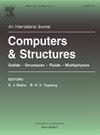Automatic yield-line analysis of out-of-plane loaded masonry cladding panels
IF 4.4
2区 工程技术
Q1 COMPUTER SCIENCE, INTERDISCIPLINARY APPLICATIONS
引用次数: 0
Abstract
To design out-of-plane loaded masonry cladding panels, as well as modern non-loadbearing masonry panels, the yield-line method has become widely used by engineers, and features in various design codes. However, the traditional hand-based yield-line analysis method can be challenging to apply to complex or irregular shapes, since the form of the critical yield-line pattern will generally not be known in advance. The discontinuity layout optimization (DLO) procedure, previously applied to reinforced concrete slabs, is here extended to treat masonry wall panels, with (i) the flexural moment capacity modified to take account of vertical dead loads from above; and (ii) shear failure also modelled, if critical (e.g., at damp proof course level). A key benefit of DLO is that the critical yield-line pattern can be identified automatically, with a rigorous linear programming-based formulation employed to ensure that a globally optimal solution is obtained for any given numerical discretization. Given the power of modern desktop PCs, this effectively eliminates the possibility of the critical yield-line failure mechanism being missed, allowing the presented method to be applied with confidence to both regular and complex-shaped masonry panels. A range of examples are used to demonstrate the efficacy of the approach, with solutions compared with those from analytical models and experimental tests.
平面外荷载砌体覆面板的自动屈服线分析
在设计平面外荷载砌体覆面板以及现代非承重砌体面板时,屈服线方法已被工程师广泛采用,并成为各种设计规范的特色。然而,传统的手工屈服线分析方法很难应用于复杂或不规则的形状,因为临界屈服线模式的形式通常无法预先知道。以前应用于钢筋混凝土板的不连续布局优化(DLO)程序,在此被扩展用于处理砌体墙板,(i) 弯曲弯矩能力被修改,以考虑来自上方的垂直死荷载;(ii) 剪切破坏也被模拟,如果临界的话(例如在防潮层)。DLO 的一个主要优点是可以自动识别临界屈服线模式,并采用严格的线性规划方法,确保在任何给定的数值离散化条件下都能获得全局最优解。鉴于现代台式 PC 的强大功能,这有效地消除了遗漏关键屈服线失效机制的可能性,从而使所介绍的方法可以放心地应用于规则和复杂形状的砌体面板。我们使用了一系列实例来证明该方法的有效性,并将解决方案与分析模型和实验测试进行了比较。
本文章由计算机程序翻译,如有差异,请以英文原文为准。
求助全文
约1分钟内获得全文
求助全文
来源期刊

Computers & Structures
工程技术-工程:土木
CiteScore
8.80
自引率
6.40%
发文量
122
审稿时长
33 days
期刊介绍:
Computers & Structures publishes advances in the development and use of computational methods for the solution of problems in engineering and the sciences. The range of appropriate contributions is wide, and includes papers on establishing appropriate mathematical models and their numerical solution in all areas of mechanics. The journal also includes articles that present a substantial review of a field in the topics of the journal.
 求助内容:
求助内容: 应助结果提醒方式:
应助结果提醒方式:


